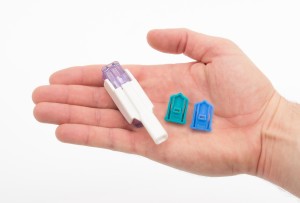What is Afrezza?

Afrezza is the brand name insulin marketed by Sanofi and developed by MannKind Corp. It is a type of rapid insulin like Novolog or Humulog that is used as meal time insulin. It is the first injectable free insulin to get approved by the FDA and wide public usage. It is an inhaler based product that comes with 4 & 8 unit cartridges depending on how your doctor prescribes it.
How do you use Afrezza?
Afrezza is unique in its dosing because of the cartridge based delivery method. Each cartridge contains either 4 or 8 units of insulin. Depending on your meal time dose you may use one or many cartridges at a time. Many patients are familiar with dosing their meal time insulin based off of carbohydrate intake or blood glucose. The only difference is that it must be in 4 unit increments. It always rounds up. That is to say that if you require 3 units of meal time insulin you round up to 4 units. If you need 5 units of insulin it is rounded up to 8 units. The following is the complete dosing recommendations(1). Your doctor may alter these recommendations if he/she wishes.
≤4 units needed: Take 4 units
5 to 8 units needed: Take 8 units
9 to 12 units needed: Take 12 units
13 to 16 units needed: Take 16 units
17 to 20 units needed: Take 20 units
21 to 24 units needed: Take 24 units

How do I start Afrezza?
There are a few requirements that must be met before starting inhaled insulin. Sense Afrezza is inhaled, your doctor must check to see if your lungs are functioning in a way that the insulin is effective. Your primary care practitioner will conduct a medical history, a physical exam and a spirometry exam(2). Spirometry is how a doctor measures how well your lungs are functioning. FEV1 is the value used to qualify someone to use inhaled insulin. This value must be 70% or greater. You cannot smoke tobacco or any other drug/medication during treatment with inhaled insulins. This will decrease the effectiveness and may lead to overly high blood glucose levels. Patients with COPD or asthma are not recommended to start inhaled insulin therapy due to poor lung function. The most observed side effect with inhaled insulin is a cough that may be seen within the first 10 minutes of taking the medication. This usually resolves after a few days but if not you may need to discontinue this type of insulin.
How does the inhaled technology work?
MannKind Corp. has developed the Technosphere technology which allows for many injectable drugs to be formulated as a dry inhaled powder(3). Technospheres are inert (no effect in the body) particles made up of fumaryl diketopiperazine, or FDKP. When sprayed or crystallized the FDKP forms small spheres with large surface area about 2 μm in diameter. The particles are then coated with the desired medication. When inhaled, the spheres dissolve instantly and your body absorbs the medication much like how you absorb oxygen from the air.
What is on the Horizon?
MannKind is currently working with other injectable drugs, trying to show their efficacy in the new inhaled dry powder formulation. Other antidiabetic medications including GLP-1 agonist, like Byetta and Victoza, are currently being tested for proof of concept using the Technosphere technology. In a 2009 report, MannKind showed in rat models that GLP/Technosphere delivery showed higher insulin levels and lower glucose levels than placebo(4). GLP-1 type antidiabetic medications offer great glycemic control and weight reductions but are not usually used in the early stages of type 2 diabetes mellitus because they have to be injected. This may offer earlier use of GLP-1 and better outcomes for patients. Other medications include parathyroid hormone, salmon calcitonin, and vaccinations are being evaluated for their effectiveness.
For more information visit Afrezza’s website: www.afrezza.com
Written by Keith Oliver, PharmD candidate
References
(1) Inhaled insulin: Drug information, Lexicomp
(2) Anastassios GP, Inhaled insulin therapy in diabetes mellitus, UpToDate, May 2015, www.uptodate.com
(3) MannKind Corporation: Dry powder technology
(4) Leone-Bay, A. Evaluation of novel particles as an inhalation system for GLP-1, MannKind publication, 2009.
